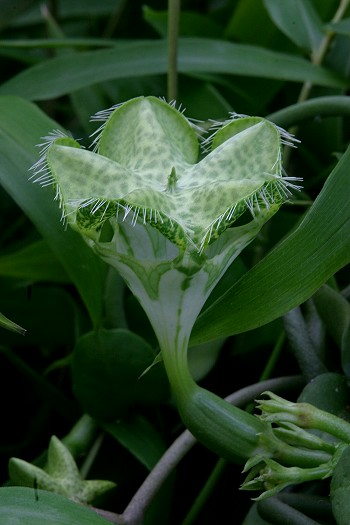
|
|
Ceropegia
flower - Ceropegia sandersonii
|
Ceropegia -
Ceropegia spp.
Ceropegias are an interesting group of plants which have attracted much attention from botanists, horticulturalists, gardeners, succulent enthusiasts. Carl Linnaeus, who first described this genus in volume 1 of his Species plantarum, which appeared in 1753, thought that the flowers looked like a fountain of wax. From this the scientific name was derived: ‘keros’ meaning wax and ‘pege’ meaning fountain (Pooley, 1998). They have many common names including lantern flower, parasol flower, parachute flower, bushman’s pipe, string of hearts, snake creeper, wine-glass vine, rosary vine, necklace vine and condom
flower.
The genus Ceropegia belongs to the Asclepiadoideae (Milkweed) sub-family within the family
Apocynaceae. Species of this genus bear similarities to the carrion flowers or
Stapelias. There are between 160 and 200 species worldwide and they are found widely from the Canary
Islands, Africa, Madagascar, Arabia, India, Sri Lanka, southern China, Indonesia, the
Philippines, New Guinea and Queensland.
Many Ceropegia species have been taken as ornamental houseplants, and some of these are commercially available. They can be propagated by seed and
cuttings.
Numerous Ceropegia species have edible tubers.
Some of these perrenial plants have succulent stems, which may be dwarf or
vine-like and posess fibrous roots, though a few species from the Canary Islands have erect growth habits. Among some species, such as Ceropegia woodii, the nodes swell, and the roots similarly expand to form tubers beneath the soil surface. The leaves are simple and opposite, although they can be rudimentary or absent. Especially in certain succulent species, the leaves may also be thick and
fleshy. Species with fleshy thickened roots are the most difficult to
grow.
Flowers occur either singly or in umbel-like clusters. Colours include
reds, purples, yellows, greens and mixtures of these. The flowers have a tubular corolla with five petals most often fused at the tips, forming an umbrella-like canopy, a cage, or appendage-like antennae (Dyer, 1983). An interesting feature of Ceropegias is that their flower tubes are lined with small hairs that point downward to form a trap for small flies. When flies are attracted into the flower by the odour they are prevented from escaping until the hairs wither, the pollinia of the Ceropegia flower being attached to the flies’ bodies when they
escape.
Ceropegia stapeliiformis is a flowering plant in the genus Ceropegia
(Apocynaceae), native to South Africa and Swaziland. Ceropegia stapeliiformis is a
prostrate, creeping, trailing or climbing succulent creeper with fibrous roots (which develop where the stems touch the
ground) and has clear sap. The leaves are minute and rudimentary, soon falling off the
stems. The flowers are 5-7 cm long and have a distinctive funnel-shape with a greenish white colour that is spotted or streaked with
maroon. The petals surrounding the mouth are free-spreading, reflexed and fringed with
hairs. The fruit a follicle with tubercles. This species is usually found rooted in leaf mould under the protection of
shrubs.
Ceropegia sandersonii is a flowering plant in the genus Ceropegia
(Apocynaceae), native to Mozambique, South Africa, and Swaziland. Common names are Parashute
plant, Fountain flower, and Umbrella plant. Ceropegia sandersonii is a prostrate, slender
twinner, nearly hairless, with sparse, succulent leaves. The roots form narrowly fusiform
clusters. The distinctive greenish white funnel-shaped (having a corolla-tube) flowers are 5–7 cm long and are placed on a delicate
stalk. Due the fact that the corolla lobes are partially fused, the opening of the flowers is partially
inhibited. The tips of the petals do not separate and form a roof or umbrella-like dome on the
flower, while the fused bottom forms the tube. The openings between the petals are also referred to as
windows, hence the name windowed flowers that is also used for flowers of this type
(Weberling, 1992). The flower itself serves as a biological myiophilous (fly-pollinated)
pitfall-trap, that traps flies when they descent into the corolla tube. Small hairs that are pointed downwards prevent the insect from
escaping. Once trapped, the victim is thoroughly pollinated and only released when the flower is left off and the hairs
weaken.
Ceropegia woodii is a flowering plant in the genus Ceropegia
(Apocynaceae), native to South Africa, Swaziland, and Zimbabwe. It is sometimes treated as a subspecies of the related Ceropegia
linearis, as C. linearis subsp. woodii. Common names include Chain of Hearts, Collar of
hearts, String of hearts, and Rosary vine. It is an evergreen succulent trailing vine that grows to 2-5 cm in height and spreads to reach up to 2-4 m in
length. Its leaves are shaped like hearts, about 1-2 cm wide and long. When exposed to sufficient light they have a deep green
colour; under insufficient lighting the leaves are pale green. With age it develops a woody caudex at its
base. The roots, and occasionally the stems, will often develop tubers. On the stems these form at nodes and are likely the reason for the common name of rosary
vine. The flower is in general form similar to those of other Ceropegia species. The corolla grows to 3 cm in length and is a mixed colouring of
off-white and pale magenta. The five petals are a deeper purple.
Ceropegia woodii is a very popular houseplant, often grown in hanging baskets so the long trailing branches can hang down with their leaves spaced out like a row of large
beads. Several cultivars have been selected, some with variegated leaves. It requires excellent
drainage, should be watered only when dry, and should never stand in water. Excess water should be removed from plant saucer after
watering. It can be grown outdoors only in subtropical and tropical areas, with a minimum temperature of 15 °C. Partial shading is useful when the plant is grown
outdoors.
Source:
http://en.wikipedia.org/wiki/Ceropegia
http://www.succulent-plant.com/families/asclepiadaceae/ceropegia.html
http://en.wikipedia.org/wiki/Ceropegia_stapeliiformis
http://en.wikipedia.org/wiki/Ceropegia_sandersonii
http://en.wikipedia.org/wiki/Ceropegia_woodii
